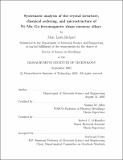| dc.contributor.advisor | Samuel M. Allen and Robert C. O'Handley. | en_US |
| dc.contributor.author | Richard, Marc Louis | en_US |
| dc.contributor.other | Massachusetts Institute of Technology. Dept. of Materials Science and Engineering. | en_US |
| dc.date.accessioned | 2006-06-20T12:52:57Z | |
| dc.date.available | 2006-06-20T12:52:57Z | |
| dc.date.copyright | 2005 | en_US |
| dc.date.issued | 2005 | en_US |
| dc.identifier.uri | http://hdl.handle.net/1721.1/33168 | |
| dc.description | Thesis (Sc. D.)--Massachusetts Institute of Technology, Dept. of Materials Science and Engineering, 2005. | en_US |
| dc.description | This electronic version was submitted by the student author. The certified thesis is available in the Institute Archives and Special Collections. | en_US |
| dc.description | Includes bibliographical references (p. 137-147). | en_US |
| dc.description.abstract | Ni-n-Ga based ferromagnetic shape-memory alloys (FSMAs) have shown great promise as an active material that yields a large output strain over a range of actuation frequencies. The maximum strain has been reported to be 6% in the tetragonal martensitic phase and up to 10% in the orthorhombic phase. There has been a large body of work exploring the engineering properties of these alloys but less extensive work in the understanding of the underlying structure and its connection to the material properties. This is particularly true for the off-stoichiometry compositions that are of most practical interest. The crystal structure of Ni-Mn-Ga ferromagnetic shape-memory alloys is extremely sensitive to composition. Several martensitic structures including tetragonal (5-layer), orthorhombic (7-layer) and non-modulated tetragonal have been identified. A systematic exploration of the composition-structure relationship has been performed using x-ray diffraction on samples taken from several single crystals with different compositions. A room temperature phase diagram has been constructed delineating the fields where the tetragonal and orthorhombic martensites are found. | en_US |
| dc.description.abstract | (cont.) Temperature-dependent magnetic and x-ray measurements have revealed markedly different transformation behavior in the tetragonal and orthorhombic materials. The orthorhombic material shows a much larger difference between the martensite start and finish temperatures as compared to tetragonal martensite. The observed difference in transformation behavior has been shown not to be related to composition inhomogeneity or the presence of intermediate martensitic phases. A thermodynamic model is proposed to explain the differences in the transition behavior by including strain energy effects in the two martensite phases that may arise during the transformation. Single-crystal and powder neutron diffraction have been employed to study for the first time the chemical ordering in the austenite and martensite phases in off- stoichiometric alloy compositions. A comparison of compositions with close to 50 at% 3Ni and those further from stoichiometry revealed the need for a more complex model for the site occupancy in alloys with a significant excess or deficiency of Ni. | en_US |
| dc.description.abstract | (cont.) The microstructure of several different Ni-Mn-Ga alloys was analyzed using transmission electron microscopy providing new microstructural data that has not been shown elsewhere. The superstructures of the different compositions has been confirmed, complementing the x-ray measurements. A hierarchal twin structure has been observed along with several second-phase particles resulting from impurities. The composition and source of the impurities has been analyzed. The twin-boundary pinning strength of the second phase particles has been estimated using the Orowan approach. This information can be used to understand why certain crystals with weak pinning sites show field-induced strain while others with very strong defect strengths do not show any actuation under an applied magnetic field. | en_US |
| dc.description.statementofresponsibility | by Marc Louis Richard. | en_US |
| dc.format.extent | 147 p. | en_US |
| dc.format.extent | 29332225 bytes | |
| dc.format.extent | 29334542 bytes | |
| dc.format.mimetype | application/pdf | |
| dc.format.mimetype | application/pdf | |
| dc.language.iso | eng | en_US |
| dc.publisher | Massachusetts Institute of Technology | en_US |
| dc.rights | M.I.T. theses are protected by copyright. They may be viewed from this source for any purpose, but reproduction or distribution in any format is prohibited without written permission. See provided URL for inquiries about permission. | en_US |
| dc.rights.uri | http://dspace.mit.edu/handle/1721.1/7582 | |
| dc.subject | Materials Science and Engineering. | en_US |
| dc.title | Systematic analysis of the crystal structure, chemical ordering, and microstructure of Ni-Mn-Ga ferromagnetic shape memory alloys | en_US |
| dc.type | Thesis | en_US |
| dc.description.degree | Sc.D. | en_US |
| dc.contributor.department | Massachusetts Institute of Technology. Department of Materials Science and Engineering | |
| dc.identifier.oclc | 64386799 | en_US |
